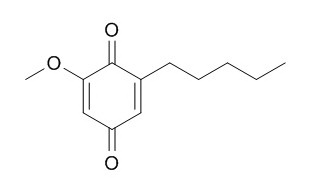Primin
Primin has antimycobacterial, and strong antineoplastic actions. Primin has potent activity against Trypanosoma brucei rhodesiense (IC50 0.144 microM) and Leishmania donovani (IC50 0.711 microM), and low cytotoxicity (IC50 15.4 microM) on mammalian cells; it could serve as a lead compound for the rational design of more potent and less toxic antiprotozoal agents.
Inquire / Order:
manager@chemfaces.com
Technical Inquiries:
service@chemfaces.com
Tel:
+86-27-84237783
Fax:
+86-27-84254680
Address:
1 Building, No. 83, CheCheng Rd., Wuhan Economic and Technological Development Zone, Wuhan, Hubei 430056, PRC
Providing storage is as stated on the product vial and the vial is kept tightly sealed, the product can be stored for up to
24 months(2-8C).
Wherever possible, you should prepare and use solutions on the same day. However, if you need to make up stock solutions in advance, we recommend that you store the solution as aliquots in tightly sealed vials at -20C. Generally, these will be useable for up to two weeks. Before use, and prior to opening the vial we recommend that you allow your product to equilibrate to room temperature for at least 1 hour.
Need more advice on solubility, usage and handling? Please email to: service@chemfaces.com
The packaging of the product may have turned upside down during transportation, resulting in the natural compounds adhering to the neck or cap of the vial. take the vial out of its packaging and gently shake to let the compounds fall to the bottom of the vial. for liquid products, centrifuge at 200-500 RPM to gather the liquid at the bottom of the vial. try to avoid loss or contamination during handling.
J Holistic Integrative Pharm.2023, 4(1):14-28
Front Pharmacol.2021, 12:690113.
Phytomedicine.2018, 47:48-57
Int J Mol Sci.2023, 25(1):283.
Biotechnology and Bioprocess Engineering2024, 29:1048-1060.
Front Pharmacol.2019, 10:1025
Molecules.2018, 23(12):E3103
J Control Release.2021, 336:159-168.
Food Res Int.2020, 128:108778
Acta Physiologiae Plantarum2015, 37:1736
Related and Featured Products
Chem Biodivers. 2006 Nov;3(11):1230-7.
Antituberculotic and antiprotozoal activities of primin, a natural benzoquinone: in vitro and in vivo studies.[Pubmed:
17193236]
Primin (=2-methoxy-6-pentylcyclohexa-2,5-diene-1,4-dione), a natural benzoquinone synthesized in our laboratory, was investigated for its in vitro antiprotozoal, antimycobacterial, and cytotoxic potential.
METHODS AND RESULTS:
Primin showed very potent activity against Trypanosoma brucei rhodesiense (IC50 0.144 microM) and Leishmania donovani (IC50 0.711 microM), and revealed low cytotoxicity (IC50 15.4 microM) on mammalian cells. Only moderate inhibitory activity was observed against Mycobacterium tuberculosis, Trypanosoma cruzi, and Plasmodium falciparum. When tested for in vivo efficacy in a Trypanosoma b. brucei rodent model, Primin failed to cure the infection at 20 mg/kg given intraperitoneally. Primin was too toxic in vivo at a higher concentration (30 mg/kg, injected i.p. route) in mice infected with L. donovani.
CONCLUSIONS:
Taken together, Primin can serve as a lead compound for the rational design of more potent and less toxic antiprotozoal agents.
Rev Inst Antibiot (Recife). 1974 Dec;14(1-2):9-16.
First observations on the topical use of Primin, Plumbagin and Maytenin in patients with skin cancer.[Pubmed:
4620478]
Eleven cases of patients bearing basic cellular carcinoma, and one case of patient bearing Kaposi's sarcomatosis, all treated with antibiotics isolated by Goncalves de Lima and Co-workers at the Instituto de Antibióticos, are presented by the authors.
METHODS AND RESULTS:
Primin, an antibiotic extracted from a vegetal named Miconia sp. (Herb. I.A.-1903) with a 2-metoxi-6-n-pentil-p benzoquinone structure, presented a strong antineoplastic action in the cases treated. Plumbagin isolated from Plumbago scandens in local use, was responsible for a complete healing of the injuries treated. Maytenin extracted from Maytenus sp. (Herb. I.A.-1750) showed less activity than the two previous mentioned, but with a low irritant action and late antineoplastic properties. The authors are going on these experiments.
CONCLUSIONS:
They believe that these antibodies, in local use, may advantageously substitute the surgery and the radiotherapy, meanly in those external ear tumidities and back of the nose, owing to a hurtful action in cartilage, provoked by radiotherapy.
Med Chem. 2007 Jul;3(4):369-72.
Synthesis and antitumour activity of the Primin (2-methoxy-6-n-pentyl-1,4-benzoquinone) and analogues.[Pubmed:
17627574]
Cancer is a serious worldwide health threat, killing almost seven million people per year. Quinones are an important class of antitumour agents that are activated by tumour hypoxia. Primin (2-methoxy-6-n-pentyl-1,4-benzo-quinone), a naturally-occurring product obtained from Primula obconica (Primulaceae) has shown antimicrobial and antitumour properties.
METHODS AND RESULTS:
The synthesis of the Primin to obtain 3-, 5- or 6-alkyl substituted derivatives has been previously attempted seeking antitumour activity. The intermediate reaction products, 2-methoxy-hydroquinone-di-(2'-tetrahydro-pyranyl) ether and 2-methoxy-6-n-pentyl-hydroquinone-di-(2'-tetrahydropyranyl) ether were obtained and evaluated against sarcoma 180 (S-180) and Ehrlich carcinoma, as well as toxicity tests were performed. The antitumour activity tests showed that these intermediate compounds were able to inhibit S-180 sarcoma and Ehrlich carcinoma growth in mice.
CONCLUSIONS:
These results indicated that the tetrahydropyranyl protect group conserved the antitumour activity in comparison with quinone group, however, it exhibited a less toxic effect, with no characteristic of quinones. These results can suggest that compound 2-methoxy-6-n-pentyl-hydroquinone-di-(2'-tetrahydropyranyl) ether may act as a prodrug with some advantages in comparison with the Primin.



